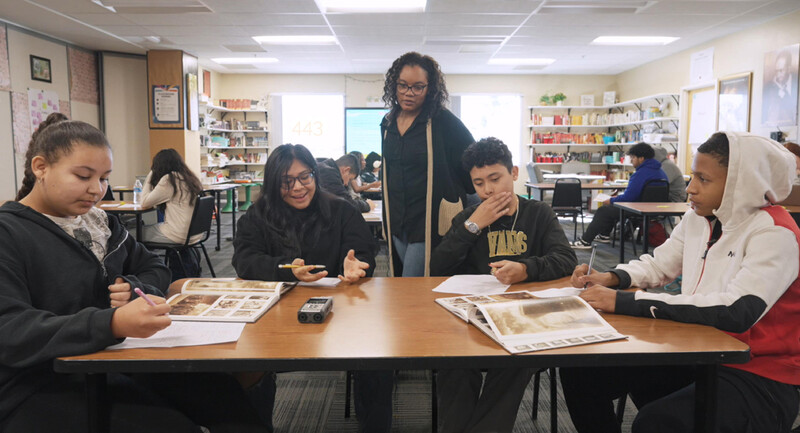Close reading is a form of dialogic teaching that provides students access to complex texts. It's a means to ensure that students engage in deep discussions about a reading.
Over the past 10 years or so, a great deal of emphasis has been placed on close reading, and we've seen increasing evidence about what works to ensure that students read and understand complex texts (Paul, 2018). But we worry that close reading is no longer "hot" and may not be used as often as it was earlier in the past decade—although it remains a great instructional tool to deepen students' understanding of texts. We've been told by several district leaders that teachers' use of close reading has declined. In our own presentations, we ask teachers how often they engage students in close reading; there is a noticeable decrease from five years ago. Allow us to revisit close reading—which we hope makes a comeback.
Interrogating and Discussing Texts
Close readings work best with short texts that don't give up their meanings easily. These texts need to be interrogated, discussed, and evaluated. Close readings are typically conducted with the whole class, although students often interact with smaller groups as they discuss their thinking. Such discussions with peers are crucial, as they deepen students' understanding of a text. It's important that teachers don't tell students what to think during a close-reading lesson. Instead, the questions teachers and students ask about the text and the peer discussions are the scaffolds used to deepen students' understanding.
Read, Read, Repeat
Traditionally, close readings have required that students annotate as they read and reread the text. While we previously recommended a system of annotation using many marks, we've revised our recommendations for teaching students to annotate, based on our own experiences and observations of over 350 close-reading lessons. We now suggest teachers focus on three foundational annotations:
Underline key ideas. In doing so, students identify important information they can use in their discussions and their writing. Teachers can circulate as students read to assess their understanding of key information just by glancing at their underlining.
Circle words and phrases that are confusing or unclear. This forces students to monitor their understanding and allows the teacher to identify gaps in vocabulary knowledge.
Create margin notes. This allows students to summarize, synthesize, and question as they read.
These three types of annotations keep students engaged as they read and reread. Notice we've said "read and reread." Repeated reading is a critical aspect of close-reading lessons, although most students don't like to do it. Wise teachers focus on changing the tasks associated with reading a passage to spark authentic reasons to reread. The first task might be a straightforward direction to read once for the "flow;" a second task might be to read and annotate. Other tasks include pressing for evidence ("Show us where you found that") and inviting students to ask questions that arise for them about the text.
Watch a Close Reading Lesson Unfold
The key to close reading remains the discussions students have with peers. The whole point is to interact with others to come to terms with what the text says and what you think about it. These conversations are facilitated with text-dependent questions that require students to provide evidence from the text.
In the video accompanying this column, Javier Vaca, a U.S. history teacher at Health Sciences High and Middle College in San Diego, engages his students in a close reading of President Franklin Delano Roosevelt's 1933 Inaugural Speech. As you'll notice in the video, the order of the questions during a close-reading lesson is critical (Fisher et al., 2015). Students aren't likely to be able to answer inferential questions at the outset of reading a complex text. Thus, teachers often start with literal level questions—perhaps "right there" questions whose answers can be found in a specific line of the text (Raphael & Au, 2005). The number of literal questions a teacher asks depends on students' responses; if students' annotations and early responses to a text suggest initial levels of comprehension, the lesson can progress quickly to structural questions, which focus on internal decisions the writer has made, such as choice of genre, organizational structure, role of the narrator, the choice of words and what they mean, and so on. If students' early responses suggest they aren't ready to progress beyond initial levels, the focus remains here a bit longer, as students consider key details and general understandings.
As students discuss structural questions, they come to understand that writing is an intentional process. Writers can take actions to impact the reader. Students get a glimpse inside the mind of the writer as they discuss craft. Thus, they move deeper into the text—and their writing often improves.
Once it's clear that students understand the text at the literal and structural levels, the questions move to inferential questions. These encourage students to discuss the deeper themes and intentions of the text and how this text compares with others. Inferential questions often have many right answers or ways to get there. Using reasoning to support claims with evidence is paramount. Typically, the teacher only needs to pose a few inference questions because at this point, discussions become extended and students begin to use evidence from the text to support their conclusions.
Giving Kids Early Success
The process outlined here provides students an opportunity to experience success from the outset of the lesson. We believe success is motivating. When students encounter complex texts and have no strategy to make meaning of the reading, they're likely to give up, to tell themselves that they're failures, that they cannot read, that any effort is fruitless. When teachers provide students early wins, students are more likely to struggle through the meaning making and critical thinking required to comprehend a challenging text.
Let's not forget about the power of close reading to deepen the discussions students have about complex texts!
Show & Tell / A Closer Look at Close Reading








